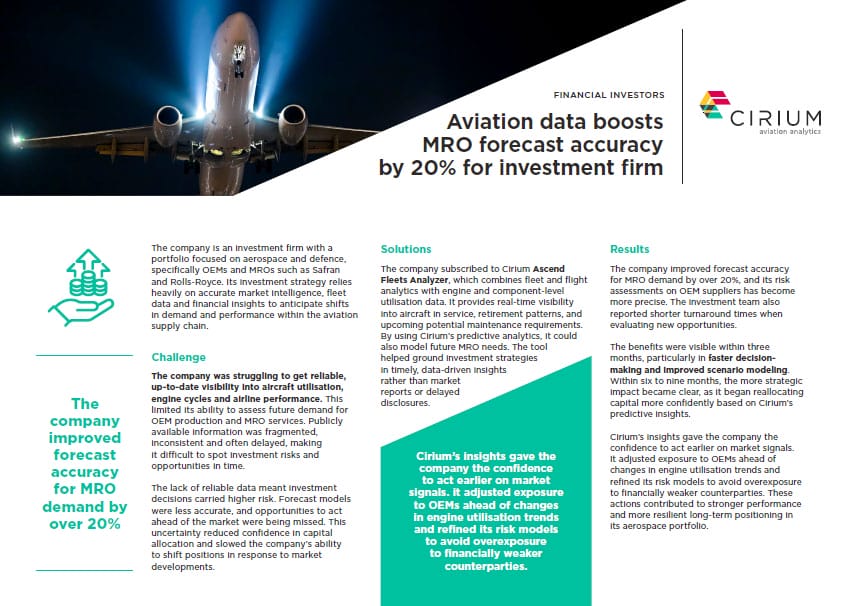
FINANCIAL INVESTORS
Aviation data boosts MRO forecast accuracy by 20% for investment firm
The company is an investment firm with a portfolio focused on aerospace and defence, specifically OEMs and MROs such as Safran and Rolls-Royce. Its investment strategy relies heavily on accurate market intelligence, fleet data and financial insights to anticipate shifts in demand and performance within the aviation supply chain.
#SOLVEDBYCIRIUM
Challenge
The company was struggling to get reliable, up-to-date visibility into aircraft utilisation, engine cycles and airline performance. This limited its ability to assess future demand for OEM production and MRO services. Publicly available information was fragmented, inconsistent and often delayed, making it difficult to spot investment risks and opportunities in time.
The lack of reliable data meant investment decisions carried higher risk. Forecast models were less accurate, and opportunities to act ahead of the market were being missed. This uncertainty reduced confidence in capital allocation and slowed the company’s ability to shift positions in response to market developments.
Solutions
The company subscribed to Cirium Ascend Fleets Analyzer, which combines fleet and flight analytics with engine and component-level utilisation data. It provides real-time visibility into aircraft in service, retirement patterns, and upcoming potential maintenance requirements. By using Cirium’s predictive analytics, it could also model future MRO needs. The tool helped ground investment strategies in timely, data-driven insights rather than market reports or delayed disclosures.
Cirium’s insights gave the company the confidence to act earlier on market signals. it adjusted exposure to OEMs ahead of changes in engine utilisation trends and refined its risk models to avoid overexposure to financially weaker counterparties.
Results
The company improved forecast accuracy for MRO demand by over 20%, and its risk assessments on OEM suppliers has become more precise. The investment team also reported shorter turnaround times when evaluating new opportunities.
The benefits were visible within three months, particularly in faster decision-making and improved scenario modeling. Within six to nine months, the more strategic impact became clear, as it began reallocating capital more confidently based on Cirium’s predictive insights.
Cirium’s insights gave the company the confidence to act earlier on market signals. It adjusted exposure to OEMs ahead of changes in engine utilisation trends and refined its risk models to avoid overexposure to financially weaker counterparties. These actions contributed to stronger performance and more resilient long-term positioning in its aerospace portfolio.

Mileways has seen app adoption grow organically, and since the beginning of 2024 it has experienced a +73% increase in downloads YoY and a 205% increase in ARR.





















































